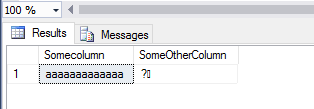
In my
The best thing about the PASS summit for me is... post I said that I would do the following
I will also do a series about new stuff in SQL Server 2016, but that will be in between all the other posts. Whenever someone asked during a session how many people were already on SQL Server 2016, very few hands went up, this is the reason, I want to blog about this as well.
For all these series of posts, I plan to have a repo on github with a yet to be determined name. Then I will have all the SQL code for all the series organized there
This is the first post in that series
You can find the github repo for the series here
whatisnewinsqlserver2016, all the code for this post can be found here
TruncatePartitions
New in SQL Server is the ability to truncate a partition or more than 1 partition, this is very nice because we all know that truncate is much faster than a delete. Let's see how this all works
First create this simple table
CREATE TABLE SalesPartitioned(
YearCol SMALLINT NOT NULL,
OrderID INT NOT NULL,
SomeData UNIQUEIDENTIFIER DEFAULT newsequentialid())
GO
Now it is time to insert some data, we are going to create data for 6 years, we will use those years then to partition the data on. This query will insert 6 times 2048 rows, 2048 rows per year
INSERT SalesPartitioned (YearCol,OrderID)
SELECT 2013,number
FROM master..spt_values
WHERE type = 'P'
UNION ALL
SELECT 2014,number + 2048
FROM master..spt_values
WHERE type = 'P'
UNION ALL
SELECT 2015,number + 4096
FROM master..spt_values
WHERE type = 'P'
UNION ALL
SELECT 2016,number + 6144
FROM master..spt_values
WHERE type = 'P'
UNION ALL
SELECT 2017,number + 8192
FROM master..spt_values
WHERE type = 'P'
UNION ALL
SELECT 2018,number + 10240
FROM master..spt_values
WHERE type = 'P'
Now let's create the partition function
CREATE PARTITION FUNCTION pfFiscalYear(SMALLINT)
AS RANGE LEFT FOR VALUES(2013,2014,2015,2016,2017)
GO
Create the partition scheme
CREATE PARTITION SCHEME psFiscalYear
AS PARTITION pfFiscalYear ALL TO ([PRIMARY])
GO
Add a primary key to the table, add it to the partition scheme we created above
ALTER TABLE dbo.SalesPartitioned ADD CONSTRAINT
PK_Sales PRIMARY KEY CLUSTERED (YearCol,OrderID)
ON psFiscalYear(YearCol)
GO
Now let's see what we have as far as counts for each partition
SELECT partition_number,rows
FROM sys.partitions
WHERE object_id = OBJECT_ID('SalesPartitioned')
Here are the results
partition_number
rows
1
2048
2
2048
3
2048
4
2048
5
2048
6
2048
As you can see we have 6 partitions, each partition has 2048 rows
We can verify this by running a count ourselves
SELECT YearCol, $PARTITION.pfFiscalYear(YearCol) AS Partition,
COUNT(*) AS [COUNT] FROM SalesPartitioned
GROUP BY $PARTITION.pfFiscalYear(YearCol),YearCol
ORDER BY Partition;
GO
YearCol
Partition
COUNT
2013
1
2048
2014
2
2048
2015
3
2048
2016
4
2048
2017
5
2048
2018
6
2048
Now it is time to truncate a partition.
In order to truncate a partition, you use the following syntax
TRUNCATE TABLE ........
WITH ( PARTITIONS ( { <partition_number_expression> | <range> } [ , ...n ] ) )
So if we just want to truncate partition 2, we would execute the following
TRUNCATE TABLE SalesPartitioned
WITH (PARTITIONS (2));
GO
Checking those same count queries from before shows that partition 2 has no rows after we executed the truncate command
SELECT partition_number,rows
FROM sys.partitions
WHERE object_id = OBJECT_ID('SalesPartitioned')
partition_number
rows
1
2048
2
0
3
2048
4
2048
5
2048
6
2048
SELECT YearCol, $PARTITION.pfFiscalYear(YearCol) AS Partition,
COUNT(*) AS [COUNT] FROM SalesPartitioned
GROUP BY $PARTITION.pfFiscalYear(YearCol),YearCol
ORDER BY Partition;
GO
YearCol
Partition
COUNT
2013
1
2048
2015
3
2048
2016
4
2048
2017
5
2048
2018
6
2048
There are two ways you can truncate a bunch of partitions, for example if you want to remove 4,5 and 6, you can use WITH (PARTITIONS (4, 5, 6)) or you can use a range like shown in the code below
TRUNCATE TABLE SalesPartitioned
WITH (PARTITIONS (4 TO 6));
GO
After we execute that and we check the counts again, we see that we are now only left with partitions 1 and 3
SELECT partition_number,rows
FROM sys.partitions
WHERE object_id = OBJECT_ID('SalesPartitioned')
Here are the results from that query
partition_number
rows
1
2048
2
0
3
2048
4
0
5
0
6
0
SELECT YearCol, $PARTITION.pfFiscalYear(YearCol) AS Partition,
COUNT(*) AS [COUNT] FROM SalesPartitioned
GROUP BY $PARTITION.pfFiscalYear(YearCol),YearCol
ORDER BY Partition;
GO
Here are the results
YearCol
Partition
COUNT
2013
1
2048
2015
3
2048
What happens if you specify an invalid partition in your truncate statement?
TRUNCATE TABLE SalesPartitioned
WITH (PARTITIONS (12));
You get the following message
Msg 7722, Level 16, State 2, Line 1
Invalid partition number 12 specified for table 'SalesPartitioned', partition number can range from 1 to 6.
There you have it, this is how truncate partitions work
You can find the github repo for the series here
whatisnewinsqlserver2016, all the code for this post can be found here
TruncatePartitions












